Short Book Reviews
Hanna Kryszewska, Poland
Hanna Kryszewska is a teacher, teacher trainer, trainer of trainers. She is a senior lecturer at the University of Gdańsk, and EU Teacher Training College where she trains pre-service teachers. She is co-author of resource books: Learner Based Teaching, OUP, Towards Teaching, Heinemann, The Standby Book, CUP, Language Activities for Teenagers, CUP, The Company Words Keep, DELTA Publishing, and a course book series for secondary schools: ForMat, Macmillan. She is also co-author of a video based teacher training course: Observing English Lessons. Hania is a Pilgrims trainer and editor of HLT Magazine.
E-mail: hania.kryszewska@pilgrims.co.uk
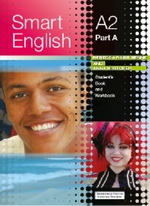
Smart English: A2 Student’s Book. Workbook and revision, Video Pack. Rebecca Robb Benne and Anna Whitcher. Brookmead English Language Teaching. (2012. ISBN 978-1-905248-50-6, ISBN 978-1-905248-51-3 and ISBN 978-1-905248-53-7, pp. 144, pp.68 and pp. 72, respectively. This is a new course for teenagers and young people learning English to pass the Cambridge English KET exams and other exams at this level. The choice of topics, very many of which have a strong CLIL element, is very relevant to the age of the learners, and I am sure that learners from all over the world will find the course interesting and motivating. The book has a cosmopolitan ring to it also thanks to the visual materials which feature peers of the learners who come from all over the globe. The lanaguage that is taught presents the authentic language young people all over the world may use to communicate in English. The course is truly modern as it requires the use of on-line resources and has a strong DVD/video component corelated which each unit of the book. The workbook promotes self study through varied exercises and systematic compilation of a portfolio.
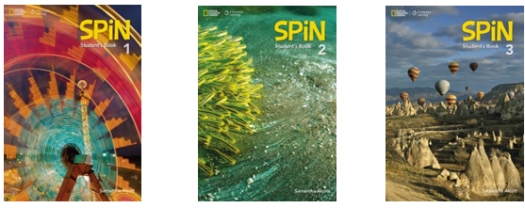
Spin 1, 2, 3. Student’s Book. S. Alcott. CENGAGE Learning and National Geographic. S. Alcott (2013). ISBN 978-1-4080-6083-4, ISBN 978-1-4080-6088-9, ISSN 978-1-4080-6105-3, pp 134, pp134 and pp 138, respectively. This is a new three level course (A1- B1) which like many CENGAGE / National Geographic books offers a true language adventure. Teenagers and young people who are the addressees of the course learn grammar, vocabulary and the four language skills, all of which serve a practical and communicative purpose. As for the topics, the learners learn English through a journey around the globe. They learn about places, people, culture and the environment. What I like a lot is that there is a strong component devoted to cultural tolerance, understanding and sensitivity, and an ecological component devoted to concern for the planet. A wealth of beautiful photography helps in this journey of discovery.

Grammar Songs & Raps. For young learners and early teens. H. Puchta, G. Gerngross, C. Holzmann and M. Devitt. Helbling Languages (2012) ISBN 978-3-85272-423-2, pp.140. This book has been published in the well established Photocopiable Resource Series in which leading ELT authors publish their materials for teachers to use and enjoy. The book in question is devoted to grammar practice through rhythm based texts such as songs and raps. At first the book is a bit hard to navigate through as the contents page contains just a list of titles. Although at the beginning of each activity the authors list the language focus, level , time etc…, trying to find what you need for your class might take some time. The page that each of us wants to consult in the first place is the Quick–reference Guide on pp 138-139. There you find a map of the book in a grid form where the level, grammar structure/s, lexical sets or topics of the song/rap are listed. What is more it states if there is an audio recording of the song / rap ( there always is) and whether relevant flashcards are available. The book comes with two CD’s on which you find 38 tracks with recordings of the raps, songs and karaoke version of the songs, and a CD-ROM which contains 130 flashcards to print out and to use in class. The activities around the songs and raps are great fun. I am sure every teachers and class will discover many new favourites in this book.
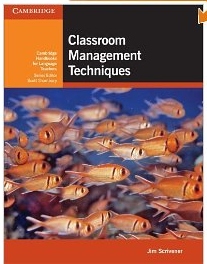
Classroom Management Techniques. J. Scrivener. (2012) Cambridge. ISBN 978-0-521-74185-9, pp 306. This book has been published in the well established Cambridge Handbooks for Language teachers in which leading ELT figures, authors, and trainers offer of an overview of a given area. The series just like the book in question is aimed at teachers who are native or non-native speakers of English, who teach at various levels, various age group, and in various settings and educational environments. Classroom management is not an exception although not every reader will benefit to the same extent from the book or its parts. The book addresses such areas of classroom management as: the classroom, the teacher, the learners, teacher interventions, whole class work, pair work and group work, discipline, and various aspects of classroom management like lesson routines, timing and pace, using materials, using technology and no technology, and homework. As an experienced teacher and trainer I believe that there is no area that has been left out. This exhaustive book is a very useful publication for teacher training courses including CELTA and DELTA. It can be used for self-study as well as for preparing teacher training input sessions. A most welcome and up-to date publication.
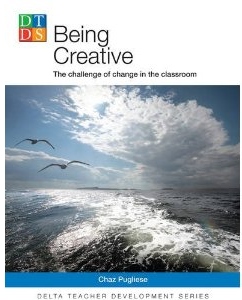
Being Creative. The challenge of change in the classroom. Chaz Pugliese. (2010) DELTA. ISBN 978-1-905085-33-0, pp 96. This book was published in the DELTA Teacher Development Series some time ago but I never got round to reviewing it. This was probably the case because Chaz Pugliese is a colleague and friend at Pilgrims, and I have had a chance to see many of the ideas described in the book presented during in-house teacher training. It is a great pleasure to see that all the great ideas have finally been collected in one publication. It truly represents the Pilgrims spirit whose essence has always been creativity and innovation. Years back we all got inspired by John Morgan and Mario Rinvolucri, the founding fathers of Pilgrims. Chaz Pugliese belongs to the younger generation and it is good to see that the spirit lives on. The book offers a wealth of creative ideas on how to use the classroom, resources and the collective knowledge of the world the students bring nto class. But above all it shows teachers how they themselves can be creative and don’t have to rely on published materials. Also it shows how learners can be creative and contribute to the lesson. In this way the book takes the teacher and the learners on a learning curve of creativity. Self esteem is the core of creativity which in turn is very humanistic. I am sure you will love this book as you will see how you yourself and your learners start to change.
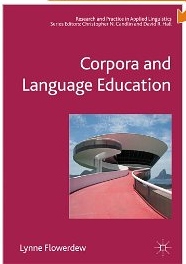
Corpora and Language Education. Lynne Flowerdew. (2012) Palgrave Macmillan. ISBN 978-1-4039-9893-4, pp 347. This is a very interesting book. It gives an overview of corpus studies; the history and conceptual background. The book reviews the main approaches to corpus based linguistics and highlights the main voices in the debate on how corpus linguistics has contributed to our understanding of how language works and how a language is learned, and above all how it affects our methodology of language teaching and our pedagogy. The book falls into four main chapters devoted to discussions of the key concepts and approaches, the nexus of corpus linguistics, textlinguistics and sociolinguistics, applications of corpora research and teaching arenas, and resources. I believe the book is a must for DELTA courses as well as post-graduate and PhD students. It will also be extremely useful with BA and MA students on university courses; those who want to branch out into corpus analysis or just need to explore an example of perfect academic writing.

Please check the Methodology and Language for Primary Teachers course at Pilgrims website.
Please check the Methodology and Language for Secondary Teachers course at Pilgrims website.
Please check the Creative Methodology for the Classroom course at Pilgrims website.
Please check the Methodology for Teaching Spoken Grammar and English course at Pilgrims website.
Please check the How to be a Teacher Trainer course at Pilgrims website.


|